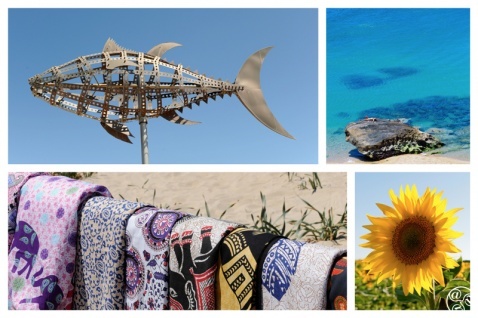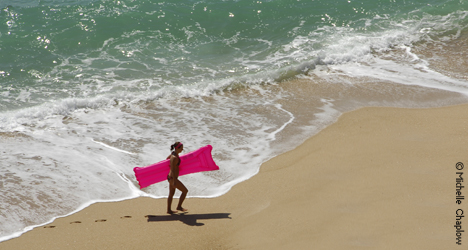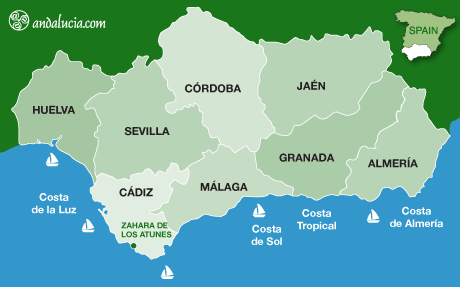
Zahara de Los Atunes |
|
Zahara de los Atunes
by Fiona Flores-Watson and Chris Chaplow
Zahara de los Atunes is one of the most charming, and fashionable, towns on the Cadiz Costa de la Luz.
With a stunning beach, boasting crystal-clear waters and golden sand, Zahara's main advantage over some other beach resorts in the area, which consist largely of hotels (albeit low-rise) and restaurants lining a beachfront road, is its villagey feel. Fishermen still ply their trade here, so it has authentic character, rather than just being designed for tourists. The restaurants and tapas bars offer excellent fish and seafood, expecially the local tuna (atun rojo de almadraba, or Atlantic bluefin) for which the town is named, as well as Retinto beef - you can see these long-horned cattle on the beach.
Zahara's Costa de la Luz clear waters and long sandy beaches make this coastal destination a perfect stop for those interested in watersports like diving, kite and wind surfing. Tarifa is just a… More →
Like many coastal towns, Zahara has a good selection of self-catering apartments and villas available for those who prefer self-catering accommodation over a hotel. Many of the apartments are… More →
In Zahara de los Atunes, there is an abundance of accommodation options, ranging from self-catering villas and apartments to hotels and hostels. The vast majority of hotels in Zahara have direct… More →
Every year in May, after the first full moon, fishermen from towns on the Cadiz part of the Costa de la Luz, including Barbate, Zahara de los Atunes, Conil de la Frontera, and Tarifa, set up a… More →
Comes provide a daily bus service M-912 from Cadiz city (departing 11.00), San Fernando, Chiclana, San Andres golf, El Colorado to Conil de la Frontera, continuing on to Vejer, La Barca de Vejer,… More →
Zahara de los Atunes is one of the most charming, and fashionable, towns on the Cadiz Costa de la Luz. With a stunning beach, boasting crystal-clear waters and golden sand, Zahara's main advantage… More →
History
The roots of the settlement date back to Phoenician times - these eastern Mediterranean people invented the almadraba tuna-fishing net/trap system which is still used to this day. Until the 16th century it was simply a fishing village, as one of the most important tuna traps of Andalucia was located here.
The earliest document naming Zahara is probably the treaty of accommodation between Vejer and Tarifa dated 1444 AD. The settlement was established following the granting of a licence for tuna-fishing granted by Sancho IV of Castile to Alonso Perez de Guzman (known as Guzman el Bueno). This privilege still belongs to his descendants, the Dukes of Medina Sidonia, who own the almadraba of Zahara.
Following the granting of this licence, in the first half of the 15th century, the family built the Castillo de Zahara de los Atunes and Palacio de Jadraza. Strategically placed in the Straits of Gibraltar, the fortified bulding served three functions: as a fortified castle to protect the tuna traps against Barbary (North African) pirates; a residential palace during the tuna season; and a processing plant to deal with the tuna.
From the early 16th century, thanks to excellent tuna harvests, Zahara was permanently populated by merchants, soldiers and tuna fishermen, who butchered poached fish in the church.
Today, in the village itself you can see the ruins of the castle, which was later used by local fishermen to store their tuna-fishing equipment.

Where to stay and eat
You can find a number of excellent restaurants with contemporary décor and lively atmosphere, including Restaurant Antonio, Zoko, which has a number of different venues, and Taberna Trastero. Be sure to order the atun rojo, especially in season (April to June): the finest dish is atun tartare, or raw tuna, alowing you to appreciate fully the rich flavour and soft texture of this magnificient fish.
The Zahara Hotels, which have increased in numbers over recent years, offer breathtaking views of the famed beaches. A few modern resort hotels sit alongside the traditional beach cabins and hostels, but when it comes to accommodation, a particular favourite is the Hotel Doña Lola, which despite being modern, is a good choice for its pleasant atmosphere and immaculately clean rooms. There is an excellent little pizzeria next door which is a great spot for an informal bite to eat. For a sea view, enjoy a drink on the beachfront in the bar of the Gran Hotel Sol.
For those who prefer the privacy of a villa, there are a number of luxury rental properties in the area, including some stylishly-designed properties with minimalist architecture.
What to see
Playa de Carmen is the main beach, with sun-loungers to rent and chiringuitos (beach restaurant/bars) for an alfresco seafood lunch, with Atlanterra next along the coast to the south, in front of the new residential development. To the north is Playa del Retin, favoured by naturists.
Apart from traditional seaside activities like going to the beach, and eating ice-cream, the delicious boutiques, sometimes complete with pretty seating areas outside, tempt with hippy-chic frocks, kaftans and sandals, as well as original gifts themed around the eponymous tuna such as T-shirts and ceramics. Look out for ceramicists' studios where you can buy their wares directly.
Check out the little market, Mercado de Abastos, selling fresh local fruit and veg, as well as (of course) fish and beef. At night, the chiringuitos come alive with cocktails and DJs.
What to do
Like its neighbour Tarifa, along the Costa de la Luz to the south-east, Zahara is a popular destination for kitesurfers and windsurfers. You can also go cycling or horse-riding.
Foodies will enjoy the Ruta de Atun (Tuna Route) in May, when restaurants offer special tuna dishes, while in September the Ruta del Retinto celebrates the local variety of beef. Both take place at weekends and feature competitions for the best tapa.
Surfing in Zahara
Book Surfing Lessons in Zahara
How to get there
Zahara de las Atunes is located 30 km north of Tarifa on the Atlantic coast, between Barbate and the Roman ruins of Baelo Claudia, off the N-340 road - look out for the turning next to Venta el Retin bar at km 56. A large part of its attraction is the stunning wilderness of 20km of unspoilt sandy beaches stretching as far south as Cape Gracia. You can drive south from Zahara as far as the lighthouse on the cape and explore the beaches. This is a no-through road (for cars), which is why the area has remained so unspoiled.
